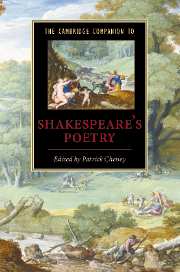Book contents
- Frontmatter
- Introduction: Shakespeare’s poetry in the twenty-first century
- 1 Shakespeare and the development of English poetry
- 2 Rhetoric, style, and poetic form
- 3 Print and manuscript
- 4 Venus and Adonis
- 5 The Rape of Lucrece
- 6 The Passionate Pilgrim and ‘The Phoenix and Turtle’
- 7 The Sonnets
- 8 A Lover’s Complaint
- 9 Poetry, politics, and religion
- 10 Love, beauty, and sexuality
- 11 Shakespeare and classicism
- 12 Poetry in Shakespeare’s plays
- 13 Poetry and performance
- 14 Reception and influence
- Reference works on Shakespeare’s poetry
- Index
12 - Poetry in Shakespeare’s plays
Published online by Cambridge University Press: 28 May 2007
- Frontmatter
- Introduction: Shakespeare’s poetry in the twenty-first century
- 1 Shakespeare and the development of English poetry
- 2 Rhetoric, style, and poetic form
- 3 Print and manuscript
- 4 Venus and Adonis
- 5 The Rape of Lucrece
- 6 The Passionate Pilgrim and ‘The Phoenix and Turtle’
- 7 The Sonnets
- 8 A Lover’s Complaint
- 9 Poetry, politics, and religion
- 10 Love, beauty, and sexuality
- 11 Shakespeare and classicism
- 12 Poetry in Shakespeare’s plays
- 13 Poetry and performance
- 14 Reception and influence
- Reference works on Shakespeare’s poetry
- Index
Summary
The truest poetry is the most feigning.
(As You Like It, 3.4.14)In addition to writing such freestanding poems as Venus and Adonis or A Lover's Complaint, Shakespeare makes poetry an integral feature of his dramatic corpus. Most obviously, he writes much of this corpus in poetic verse, whether in blank verse or in rhyme (see Chapters 1 and 2 in this volume). But he also includes over 130 lyrics in his plays, as poems or songs, with over 100 of them original compositions. Not simply, then, are his plays made largely of poetry but set-lyrics appear in them. Most often, Shakespeare clarifies the poet-figures who write, sing, or perform these lyrics, such as the courtier Orlando in As You Like It, who fondly hangs his love poems to Rosalind on trees in the Forest of Arden. In Shakespeare's plays, the performance of poetry becomes a recurrent stage action, and the presence of active poet-figures means that characters habitually carry on a conversation about poetry. The epigraph to this chapter registers one such conversation, when the court clown Touchstone in As You Like It, also visiting the Forest of Arden, tries to woo the country girl Audrey:
touchstone Truly, I would the gods had made thee poetical.
audrey I do not know what ‘poetical’ is. Is it honest in deed and in word? Is it a true thing?
touchstone No, truly; for the truest poetry is the most feigning.
(3.4.10–14)If the tone of this conversation is playful, the terms are aesthetically serious, confirming that Shakespeare imagines poetry as both a language and an action (‘deed and word’), and showing the author to enter a historical debate about the nature of poetry and the new medium it serves: theatre, as the climactic word ‘feigning’ perhaps hints. In Shakespearean drama, the conversation the audience hears turns out to exist in detailed, compelling form from the beginning of his dramatic career to the end – from The Two Gentlemen of Verona to The Tempest – and constitutes a sustained yet neglected fiction about the art of poetry within the plays.
- Type
- Chapter
- Information
- The Cambridge Companion to Shakespeare's Poetry , pp. 221 - 240Publisher: Cambridge University PressPrint publication year: 2007



